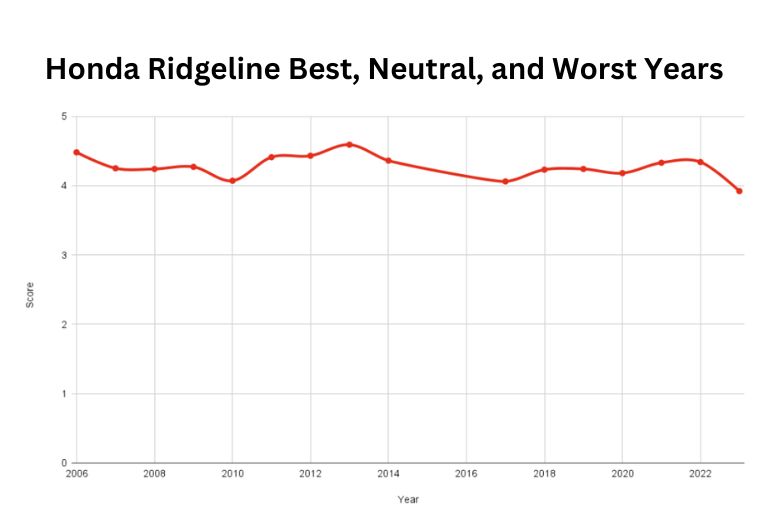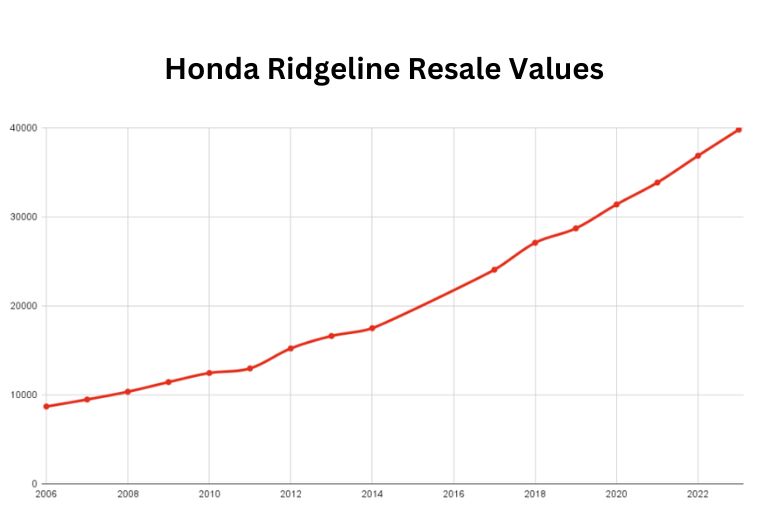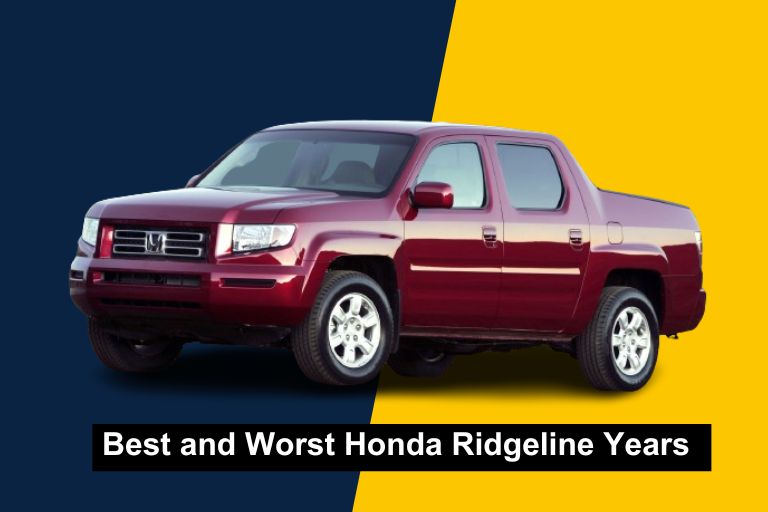The Honda Ridgeline has been a standout in the midsize truck market, offering a unique combination of comfort, versatility, and reliability. All model years are not created equal. In this comprehensive guide, we delve into the best and worst Honda Ridgeline years to help you make an informed decision when considering this popular truck option.
From groundbreaking innovations to notorious mechanical issues, each year of the Honda Ridgeline comes with its own set of pros and cons that can greatly influence your ownership experience.
Whether you’re a first-time buyer or a seasoned enthusiast, understanding the nuances of each model year is crucial in selecting the perfect Honda Ridgeline that suits your needs and preferences. Join us on a journey through time as we uncover the top picks and cautionary tales in the world of Honda Ridgeline trucks.
You can also read:-
Best and Worst Honda CR-V Years
Honda Ridgeline Generations
The evolution of the Honda Ridgeline across its generations is a captivating journey that showcases the innovative spirit and unwavering commitment to quality of this beloved truck. From its humble beginnings to its current state-of-the-art design, each iteration of the Honda Ridgeline tells a story of progression and refinement.
We delve into the different generations of this iconic vehicle, we witness how Honda has consistently pushed boundaries and redefined what it means to be a versatile and reliable pickup truck in today’s automotive market. Join us on an exciting exploration through time as we uncover the fascinating transformations and advancements that have shaped the legacy of the Honda Ridgeline across its generations.
Honda Ridgeline Best, Neutral, and Worst Years
The best and worst Honda Ridgeline years are often considered to be 2017 and onwards. These newer models offer improved technology features, enhanced safety systems, and a more refined interior design.
The latest Ridgeline also boasts a smooth ride quality and strong towing capacity, making it a versatile choice for both everyday driving and outdoor adventures.
The neutral years for the Honda Ridgeline fall within the 2006-2014 range. While these models may lack some of the modern amenities found in newer versions, they still hold up well in terms of reliability and performance.

Many owners appreciate these earlier Ridgelines for their practicality, comfortable seats, and innovative in-bed trunk storage feature.
In contrast, some consider the worst years for the Honda Ridgeline to be during its early production years from 2005 to 2008. These models faced criticism for their boxy exterior design, lower fuel efficiency compared to competitors, and limited off-road capabilities.
Subsequent model years saw improvements in these areas as Honda continued to refine and update their midsize truck offering.
Best and Worst Honda Ridgeline Years of 1st Generation (2006-2014)
The best and worst Honda Ridgeline years from its first generation, the 2012 model stands out as a top pick. This year saw improvements in fuel efficiency, a more powerful engine, and updated technology features that enhanced overall performance.
The 2006 Ridgeline faced criticism for its lackluster acceleration and road noise issues, making it one of the least favored options within this time frame.

Moving on to the 2009 Honda Ridgeline, it garnered appreciation for its comfortable ride quality and spacious interior. some drivers were disappointed by its dated infotainment system and underwhelming towing capacity compared to competitors in the market.
It’s clear that each year of this generation has its strengths and weaknesses, emphasizing the importance of thorough research before deciding on a specific model.
The Best Years: 2009, 2010, 2011, 2012, 2013, 2014
As we dive into the timeline of Honda Ridgeline’s first generation, some years stand out as truly exceptional models while others fall short of expectations. In 2009, the Ridgeline received praise for its versatile cabin design and smooth ride quality, positioning it as a top contender in the midsize truck market.
Moving on to 2011, Honda made significant improvements by introducing a more fuel-efficient engine and updating the interior amenities. This year marked a turning point for the Ridgeline, earning it high marks for reliability and practicality.
Fast forward to 2012, where Honda impressed consumers with enhanced towing capabilities and improved off-road handling, solidifying its position as one of the best years in the lineup. And while 2013 brought minor updates to exterior styling and safety features, it failed to make a significant impact on critics or buyers alike.
Finally, in 2014, Honda faced criticism for falling short on innovation compared to rival models entering the market. Despite this setback, loyal fans appreciated the Ridgeline’s consistent performance and versatile bed design that set it apart from other trucks in its class.
Each year brought its own set of strengths and weaknesses to the table – making it essential for buyers to carefully consider their priorities when choosing between these model years.
The Worst Years: 2006, 2007, 2008
In the automotive industry, the years 2006, 2007, and 2008 marked a turbulent period for Honda Ridgeline enthusiasts. Despite its innovative design and versatility, these particular years of the first-generation model faced criticism for various shortcomings that hindered their performance and reliability.
Owners reported issues such as transmission problems, premature brake wear, and electrical failures that soured the otherwise promising experience offered by this unique pickup truck.
Amidst the challenges faced during these years, there were still shining moments for the Honda Ridgeline. The vehicle’s unmatched interior comfort and clever storage solutions continued to impress drivers looking for a practical yet comfortable ride.
While some may deem these years as among the worst for the Ridgeline lineup, it’s crucial to acknowledge that they also paved the way for improvements in later models. The lessons learned from addressing these early issues helped Honda refine its approach to building reliable and resilient trucks in subsequent years.
Best and Worst Honda Ridgeline Years of 2nd Generation (2017-Present)
The best and worst Honda Ridgeline years of the second generation, the 2017 model stands out as a solid choice. This year marked the beginning of the second generation for the Ridgeline, offering a smooth ride, spacious interior, and innovative features.
Some critics point to the 2020 model as one of the less impressive years due to its higher starting price compared to competitors and lack of significant updates.

In contrast, many enthusiasts praise the 2019 Honda Ridgeline for its comfortable cabin and versatile bed design. The addition of standard safety features also added to its appeal. some drivers have expressed disappointment with this model’s towing capacity compared to rival trucks in its class.
Each year of the second-generation Honda Ridgeline has its own strengths and weaknesses, catering to different preferences among truck buyers seeking reliability and modern amenities in a midsize pickup.
The Best Years: 2020, 2021, 2022, 2023
The years 2020 to 2023 marked key milestones for the Honda Ridgeline, with each year offering a blend of both excellence and challenges. In 2020, the Ridgeline stood out for its reliability and comfort, appealing to drivers seeking a dependable ride. Some critics highlighted minor issues that marred its overall performance.
Transitioning into 2021, the Honda Ridgeline showcased improvements in technology and safety features, cementing its position as a top choice in the midsize truck segment. Despite this progress, concerns arose regarding its towing capacity and fuel efficiency compared to competitors in the market.
Looking ahead to 2022 and beyond holds promise for the Ridgeline as Honda aims to address these shortcomings while further enhancing the truck’s design and capabilities.
As we move closer to 2023, anticipation brews around what innovations Honda will introduce in their next model year release. The best may be yet to come as Honda dedicates themselves towards perfecting their iconic Ridgeline series – each year bringing new advancements that redefine what it means to drive a midsize truck on today’s roads.
The Worst Years: 2017, 2018, 2019
The years 2017, 2018, and 2019 marked a tumultuous period for Honda Ridgeline enthusiasts. While the second generation of this vehicle boasted impressive technological advancements and design updates, these specific years saw mixed reviews from consumers.
In 2017, the Ridgeline introduced innovative features such as the truck bed audio system and dual-action tailgate that garnered praise but also faced criticism for its higher price point compared to competitors.
As we move into 2018, Honda made incremental changes to improve fuel efficiency and overall performance. concerns arose over reported transmission issues in some models that raised questions about the vehicle’s reliability.
The year 2019 brought further enhancements with updated safety features and infotainment options but fell short in addressing long-standing complaints about interior comfort and cabin noise levels. Despite these challenges, each year offered unique improvements that shaped the evolution of the Honda Ridgeline throughout its second-generation lifespan.
Honda Ridgeline Resale Values
The best and worst Honda Ridgeline years has shown some interesting trends within its second generation (2017-Present). The best years for resale value tend to be the more recent models, with the 2020 and 2021 Ridgelines holding their value particularly well.
These newer models feature updated technology, improved performance, and a sleek design that buyers find appealing.

The worst years for resale value in the second generation of Honda Ridgelines are often considered to be the earlier models like the 2017 and 2018 versions. These vehicles may not have all of the latest features and upgrades found in newer models.
Which can impact their desirability on the used market. despite this trend, Honda Ridgelines overall hold their value better than many other trucks in their class due to their reputation for reliability and practicality.
When considering purchasing a used Honda Ridgeline from the second generation lineup, it’s advisable to focus on later model years like 2020 or 2021 for better resale value potential. These newer versions offer more advanced features and improvements that appeal to buyers looking for a dependable and modern truck option.
Conclusion
The Honda Ridgeline has gone through various iterations over the years, with some standout models that have proven to be reliable and innovative. The best model years for the Ridgeline include [insert specific years], known for their strong performance and advanced features.
There are certain model years to approach with caution due to reported issues such as [mention specific problems]. When considering purchasing a Honda Ridgeline, it is crucial to do thorough research on the different model years to ensure you make an informed decision. Remember to test drive any potential vehicles and consult with experts before making your final choice.
FAQ
Q.Which Honda Ridgeline year is considered the best overall?
The 2017 Honda Ridgeline is often praised for its refined interior, smooth ride quality, and innovative features.
Q. Are there any specific years of the Honda Ridgeline known for reliability issues?
The 2006 and 2008 models have been reported to have more mechanical problems compared to other years.
Q.What year of the Honda Ridgeline offers the most advanced safety features?
The 2021 Honda Ridgeline comes equipped with the latest safety technology, including adaptive cruise control and automatic emergency braking.
Q.Are there any specific years of the Honda Ridgeline that are popular among off-road enthusiasts?
The 2019 Honda Ridgeline is favored by off-road enthusiasts due to its all-wheel drive system and rugged styling.

